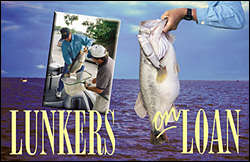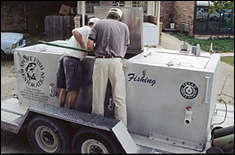|

TPWD's ShareLunker program, despite controversy and
setbacks over the years, is back on track in -literally- a big,
big way.
By Paul A. Cañada
Page 2
Past Problems
Neither Ward nor program
head David Campbell ever disputed that the high mortality rate
existed. Looking back, the two fishery biologists conclude that
there were many reasons for the high mortality. Both Campbell
and Ward consider the outdated facilities at the Tyler fish hatchery
to be the biggest single reason for the large number of dead fish.
"The Tyler facility
was very outdated and it was understood that it would eventually
be shut down," shares Campbell. "It was difficult to
work with a facility that was so antiquated. Likewise, it was
difficult for the people there to make things happen the way they
wanted to."
At the Tyler facility
the bass were held in long concrete raceways. Although the raceways
were indoors, they had no environmental controls. All Texas Parks
& Wildlife Department personnel could do was flush water through
them. According to Ward, oftentimes the temperature of the water
in the raceways reached the high 80s and stayed in that range
for long periods of time. In those conditions, the bigger fish-already
suffering from stress-couldn't find the much-needed cooler water.

Anglers calling the TPWD's ShareLunker program will soon be greeted by the program's "care" tank personnel. We must not forget, however, that the care taken in the period between catching the fish and turning it over to the program is critical to its survival.
|
Another contributing
factor was the diversion of Campbell's energy, focus and time.
The nationally-known fishery biologist explains, "My move
from the Tyler hatchery to the Freshwater Fisheries Center in
Athens took one person away from the the Tyler facility and the
program. Although I was still responsible for overseeing the ShareLunker
program, I was 34 miles away overseeing the Athens project. Additionally,"
he continues. "when I worked completely out of the Tyler
facility, I put lots of extra hours into the pro
ram and, although they tried, the remaining personnel couldn't
replace those extra hours."
Still, guides say there
was something else that was noticeably different about
the program. One of the program's greatest supporters, Lake Fork
guide Dennis States, reluctantly admits, "During the middle
years, when they were receiving a lot of fish, you could see there
was something wrong. I hate to say it, but you could see it in
how the personnel picking up the fish performed. They had no sense
of urgency."
Ward concurs that there
were problems with personnel. Campbell responds with all honesty,
"There was a period of about 3 years when it was very difficult-and
I don't want to get into personalities. The program did suffer
during those three years. However, we realized there was a problem
and we made the necessary adjustments."
Adjustments Made
Of course, the biggest
change in the program was the move to the state-of-the-art facilities
at the Freshwater Fisheries Center in Athens. According to Campbell
and Ward, the new facility was built around the ShareLunker program.
In Athens, personnel have access to exhibit tanks built especially
for handling the ShareLunker fish.
The second adjustment
Campbell made was to place Neil Ward as program coordinator. "Ward
is a high-energy, go-getter type of guy," notes Campbell.
"He has done an exceptional job at picking up the fish and
getting them back safely so that Jim Matthews, our intensive culture
expert, can care for them. Also, Ward has been instrumental in
winning the guides and marinas back to the program."
Larry Barnes agrees.
Ward's efforts were instrumental in winning back the confidence
of the reluctant Lake Fork guides. "I met with Ward three
or four times and have visited the new facilities," Barnes
reveals, "and I believe Ward's claim that the program has
turned around. I think he has a lot of credibility with the Lake
Fork guides. Because of Ward, I am again supporting the program
and have written several articles encouraging others to give the
program another chance."
A modest Ward credits
the guides' change of heart to the new facilities and the efforts
made by the entire ShareLunker team. "The guides that were
once against the program are now backing the program because they've
see the work we've done over the last two years and the low mortality.
The mortality rate for last season (1997-98) was at an all-time
low (13 percent)."
Where Do We Go From Here?
The ShareLunker program
management team of Campbell, Matthews and Ward have successfully
turned the program and the public's opinion around. Correspondingly,
hoping to make the program more appealing to anglers, Campbell
has increased the incentives. In addition to the traditional fiberglass
replica, anglers will receive an embroidered jacket and shirt,
and will be eligible for the $1,000 cash prize drawing held at
the annual banquet honoring the program's participants.
To participate in the
program-which began Dec. 1 and runs through April 30-anglers need
only be lucky enough to catch a 13-pound, Texas largemouth lunker.
However, it's critically important to contact the ShareLunker
personnel within 12 hours of catching the fish. Lucky anglers
can reach the key personnel at 1-888-784-0600.
Will the new incentives
and recent track record be enough to return the Lake Fork contributions
back to the numbers experienced during the 1994-95 season (23
entries) and the 1995-96 season (22 entries)? Lake Fork's States
is a believer.
"So far, the numbers
(3 fish by Feb. 1) look good," he says, adding that, "Most
of the big fish are caught in March. This year it looks like the
opportunities are going to be above average."
Indeed, the ShareLunker
program seems destined to succeed. However, David Campbell shares
the news that popular Neil Ward will be leaving the program and
moving back to Oregon at the end of March. The impact of Ward's
leaving will be felt mostly in the realm of public relations.
Not since its earliest years has the ShareLunker program experienced
the excitement and collective purpose that it's experiencing now.
True, much of this renewed
strength is a result of the new facilities, but arguably much
of it is due to the seemingly endless energy of Neil Ward. However,
a confident Campbell pledges, "Neil has got to be credited
with getting people back on board with our new program. However,
I believe we have the facility and the staff to continue that
same level of intense involvement in the program."
# # # #
page 1 / page 2
| 




